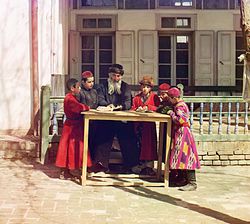| Demographics of Uzbekistan | |
|---|---|
 Population pyramid of Uzbekistan in 2023 | |
| Population | 37,896,152 (July 20, 2025) [1] |
| Growth rate | 0.83% (2022 est.) |
| Birth rate | 26.2 births/1,000 population (2022) |
| Death rate | 4.8 deaths/1,000 population (2022) |
| Life expectancy | 75.29 years |
| • male | 72.27 years |
| • female | 78.5 years |
| Fertility rate | 3.4 children born/woman (2024) [2] |
| Infant mortality rate | 18.98 deaths/1,000 live births |
| Net migration rate | -1.78 migrant(s)/1,000 population (2022 est.) |
| Age structure | |
| 0–14 years | 30.1% |
| 65 and over | 5.3% |
| Sex ratio | |
| Total | 1.01 male(s)/female (2022 est.) |
| At birth | 1.06 male(s)/female |
| Under 15 | 1.05 male(s)/female |
| 65 and over | 0.63 male(s)/female |
| Nationality | |
| Nationality | Uzbekistani |
| Major ethnic | |
| Minor ethnic |
|
| Language | |
| Official | Uzbek |
| Spoken | Russian |
Demographic features of the population of Uzbekistan include population growth, population density, ethnicity, education level, health, economic status, religious affiliations, and other aspects of the population. The nationality of a person from Uzbekistan is Uzbekistani, [3] [4] [5] while the ethnic Uzbek majority call themselves Uzbeks. Much of the data is estimated because the last census was carried out in Soviet times in 1989.




